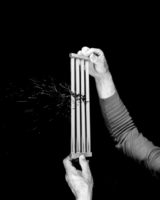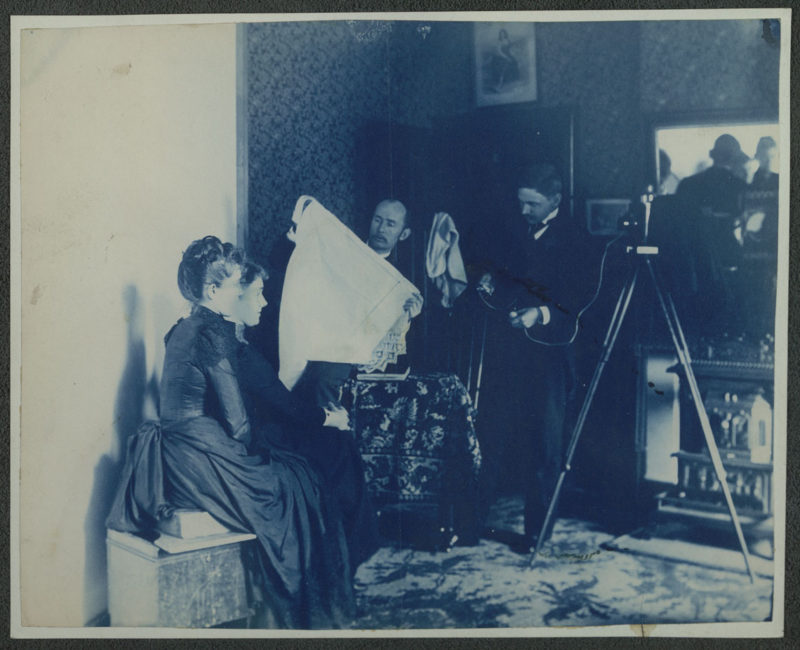In crits, I have lately come to speak of certain photographs as being made to look like photographs. On the surface, that’s a bit of an absurd kind of criticism, given that photographs always look like photographs. What I’m trying to get at goes a bit deeper, or maybe I should go it goes elsewhere. My main problem is that photographs that are make to look like photographs usually are not intended to end up that way, and they lack basic believability.
Maybe giving an example helps. The 2015 Taylor Wessing Prize winner is a picture that strikes me as a prime example of a photograph made to look like a photograph. It’s incredibly awkward. People don’t sit and act and pose that way (at least the people I know). They don’t do that unless you make them to, in which case you get a picture that looks like it was made to look that way, a picture that, however, does not look like what you would see had you come across the scene. It’s a staged-narrative photograph too aware of its own conventions, of its own artifice. It has “you sit there and prop your head up that way, and you sit there…” all over it. It is all artifice, with very little artistry.
That’s really the tough thing about photography, namely that its own artifice is embedded in it in such a strange way. For paintings, this is more obvious. You look at a painting, and you see artifice. You see the paint, the surface, the textures… But you can see beyond those, because it’s a painting. With photography, it’s not so simple at all. Photographs have no surface, so there’s nothing to see beyond. Photographs are all artifice as well. But because what we see is a frozen moment, something that usually represents what we call reality in an at least initially faithful way, we don’t tend to realize the artifice’s role easily — unless it is shoved into our faces.
So this would then be the challenge behind certain types of photography, the pushing beyond the artifice. Put someone in front of a view camera, to take a portrait, and right there is your biggest struggle: how can you make that look as if that entirely constructed, artificial setup needed to make the picture didn’t exist at all? That is really, really hard. If things are just a little bit off a viewer will notice it. In fact, if things are a little bit off that’s even worse than seeing a hot mess that doesn’t work at all. When something is a little bit off, we are led to believe someone wanted to make a picture that, well, is not that. So you see the effort going into it, and the aspirations. You see the artistic failure.
Photographs that look as if they were taken effortlessly often required considerable amounts of work. The artistry is not so much that they look effortless. Instead, it is that they look effortless despite the vast amounts of effort put into them. Usually, you cannot will that to happen. Instead, you will have to surrender to the process. And you have to have the faith that at the end of what looks like a long tunnel, you will emerge with pictures that do what you want them to do.
This assumes, of course, that you know what you want your pictures to do. That’s hard, too. You know you want to take a picture, and if you just know that then, well, there is the chance that you end up with a picture that looks like it was made to look that way. This doesn’t mean you can’t get away with that, under certain circumstances.
Gregory Crewdson made a nice career out of pictures that totally look like they were made to look that way. My guess is that for someone who has never seen a Hollywood movie and who isn’t steeped in somewhat superficial ideas of psychological drama the pictures look like the photography equivalent of Thomas Kinkade paintings. I have never met anyone who fulfills that criterion, but once I do, I’ll make sure to ask.
There also are the pushed pixels and ironic still lifes of New Formalism. That’s all very cute, and these days, you can get a lot of mileage out of them, especially with many museum curators.
The thing is that photography is interesting because of the limitations created by its own artifice. But making those limitations the center of your work — whether this was intended or not — is not interesting. That’s not cutting it in any sense of the idea of art (unless, of course, you place your own artistic bar very low). There’s no challenge. There’s no imagination at play. There’s no “what if?”
The ultimate question is to ask: how can I make my photographs do things that it seems they can’t do? How can they do that regardless? That’s where things get juicy. That’s where the fun is. That’s where aspirations enter, where you don’t go about fulfilling your expectations, but about pushing against your and your medium’s limitations.
You have got to have aspirations to make photographs. Every time someone tells you that “this has been done already,” you will have to be prepared to respond with “fuck you, I’ll show you!” Every time someone talks about there being too many photographs, the same: “fuck you, I’ll show you!”
Make people want to look at your photographs because they’re so damn good. Not because they’re so ironic or witty or self-concerned or whatever other superficial crap is being peddled so much these days.
I’ve mentioned the much maligned selfie many times before. It’s so easy to make fun of it. But most selfies are actually kind of good because their makers are so unafraid to make them. Where else do you see such a refreshing absence of anxiety around photography these days?
So ditch your anxiety. Don’t be afraid to fuck up, multiple times, until it’s not even funny any longer. As long as it’s somewhat funny, as long as it doesn’t really hurt, you’re not in the right spot. Who cares if there are thousands of negative holders or folders on your hard drive filled with bad pictures — as long as you have the few good ones in the end?
Good enough, in other words, can’t be good enough. A good-enough picture, one that looks like it was made to look that way, can’t be enough. It has to become that picture that looks like you were incredibly lucky that you just stumbled across it, even though you spent so much time making it.














